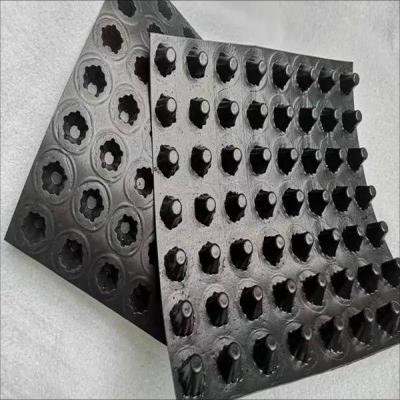Plastic drainage plates are commonly used in engineering. They can quickly discharge moisture from the foundation through the drainage channel inside them, which can improve the stability and bearing capacity of the foundation. However, the installation direction of the plastic drainage plate has an important impact on its drainage effect.
Plastic drainage boards are made of polymer materials such as polyethylene (PE) or polypropylene (PP), and are lightweight, high-strength, corrosion-resistant, and easy to construct. Its unique concave structure not only increases the drainage area, but also improves drainage efficiency. It can be used in highways, railways, water conservancy, construction and other projects, especially in soft soil foundation treatment, basement waterproofing, roof greening, etc., and plays an important role.
1. The importance of the installation direction of plastic drainage plates
The installation direction of the plastic drainage plate can determine the direction of its drainage channel and will affect the drainage effect. If the installation direction is improper, it may lead to poor drainage and even water accumulation in the foundation, seriously affecting the quality and safety of the project. Therefore, during the installation of plastic drainage boards, we must strictly follow the design specifications to ensure the correctness of the installation direction.
2. Specific requirements for the installation direction of plastic drainage plates
1. Top panel construction: When laying plastic drainage boards on the surface of garage roof panels, squares and other buildings, the convex shells are generally installed upward. In this way, the convex shell on the drainage plate can form a drainage channel so that the moisture in the soil can be discharged smoothly. The filtered seepage geotextile above the convex shell can prevent soil from clogging the drainage channel and ensure smooth drainage.
2. Bottom panel construction: When building floors such as basement floors, the plastic drainage plates must be installed with a convex shell downwards. This installation method can fill concrete into the empty shell of the drainage plate to form a waterproof layer. The holes under the drainage plate can discharge moisture from the foundation and prevent water seepage in the basement.
3. Soft soil foundation treatment: In soft soil foundation treatment, the plastic drainage plates are generally arranged in the shape of plum blossoms, and the spacing is determined according to the design requirements. The installation direction of the drainage plate must ensure that the drainage channel is consistent with the drainage direction of the foundation, so that the pore water in the foundation can be quickly discharged and the consolidation of the soft soil foundation can be accelerated.
4. Installation in special environments: In special environments, such as strong winds, heavy rains, etc., pay special attention to the protection of the drainage plate to prevent it from being blown by strong winds or being washed and displaced by rainwater. During the laying process, it is also necessary to ensure that the overlap between the drainage plates is tight to prevent soil from entering the drainage channel.
3. Things to note when installing plastic drainage board
1. Install strictly in accordance with design requirements: When installing plastic drainage boards, they must strictly follow the design requirements to ensure the correctness of the installation direction.
2. Strengthen on-site supervision: During the construction process, on-site supervision must be strengthened to ensure that construction personnel operate strictly in accordance with installation requirements.
3. Regular inspection and maintenance: After the construction is completed, the drainage plate must be inspected and maintained regularly to ensure that its drainage performance is good.
Post time: Feb-25-2025




